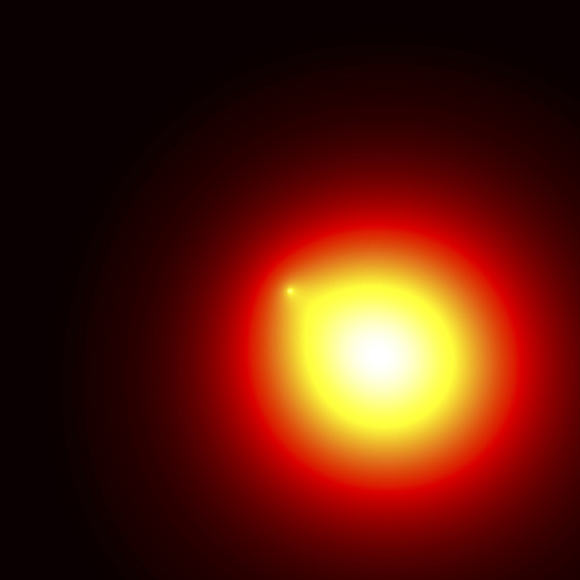Fermi Finds Enormous Gamma-Ray Halo around Nearby Pulsar | Astronomy – Sci-News.com
Using data from the Large Area Telescope (LAT) on board NASA’s Fermi Gamma-ray Space Telescope, astronomers have discovered a gamma-ray glow around Geminga, a pulsar located approximately 800 light-years away in the constellation Gemini.

A faint gamma-ray glow around the Geminga pulsar. Image credit: NASA’s Goddard Space Flight Center / M. Di Mauro.
A pulsar — a rapidly spinning neutron star — naturally surrounds itself with a cloud of electrons and positrons. This is because the neutron star’s magnetic field pulls the particles from the surface and accelerates them to nearly the speed of light.
Electrons and positrons are among the speedy particles known as cosmic rays, which originate beyond the Solar System. Because cosmic ray particles carry an electrical charge, their paths become scrambled when they encounter magnetic fields on their journey to Earth. This means astronomers cannot directly track them back to their sources.
For the past decade, measurements by Fermi, NASA’s Alpha Magnetic Spectrometer aboard the International Space Station, and other space experiments have seen more positrons at high energies than scientists expected.
“Our analysis suggests that Geminga could be responsible for a decade-long puzzle about why positrons are unusually abundant near Earth,” said Dr. Mattia Di Mauro, an astrophysicist at the Catholic University of America and NASA’s Goddard Space Flight Center.
To study the halo around Geminga, Dr. Di Mauro and colleagues had to subtract out all other sources of gamma rays, including diffuse light produced by cosmic ray collisions with interstellar gas clouds.
“We explored the data using 10 different models of interstellar emission,” said Dr. Silvia Manconi, a postdoctoral researcher at RWTH Aachen University.
What remained when these sources were removed was a vast, oblong glow spanning some 20 degrees — about 40 times the apparent size of a full Moon — at an energy of 10 billion electron volts (GeV), and even larger at lower energies.
The researchers determined that Geminga alone could be responsible for as much as 20% of the high-energy positrons seen by other space experiments.
“Extrapolating this to the cumulative emission of positrons from all pulsars in our Milky Way Galaxy, it’s clear that pulsars remain the best explanation for the observed excess of positrons,” they said.
“Lower-energy particles travel much farther from the pulsar before they run into starlight, transfer part of their energy to it, and boost the light to gamma rays. This is why the gamma-ray emission covers a larger area at lower energies,” said Dr. Fiorenza Donato, an astronomer from the Italian National Institute of Nuclear Physics and the University of Turin.
“Also, Geminga’s halo is elongated partly because of the pulsar’s motion through space.”
“Our work demonstrates the importance of studying individual sources to predict how they contribute to cosmic rays,” Dr. Di Mauro said.
“This is one aspect of the exciting new field called multimessenger astronomy, where we study the Universe using multiple signals, like cosmic rays, in addition to light.”
The team’s results were published in the journal Physical Review D.
_____
Mattia Di Mauro et al. 2019. Detection of a γ-ray halo around Geminga with the Fermi-LAT data and implications for the positron flux. Phys. Rev. D 100 (12): 123015; doi: 10.1103/PhysRevD.100.123015
This article is based on text provided by the National Aeronautics and Space Administration.





